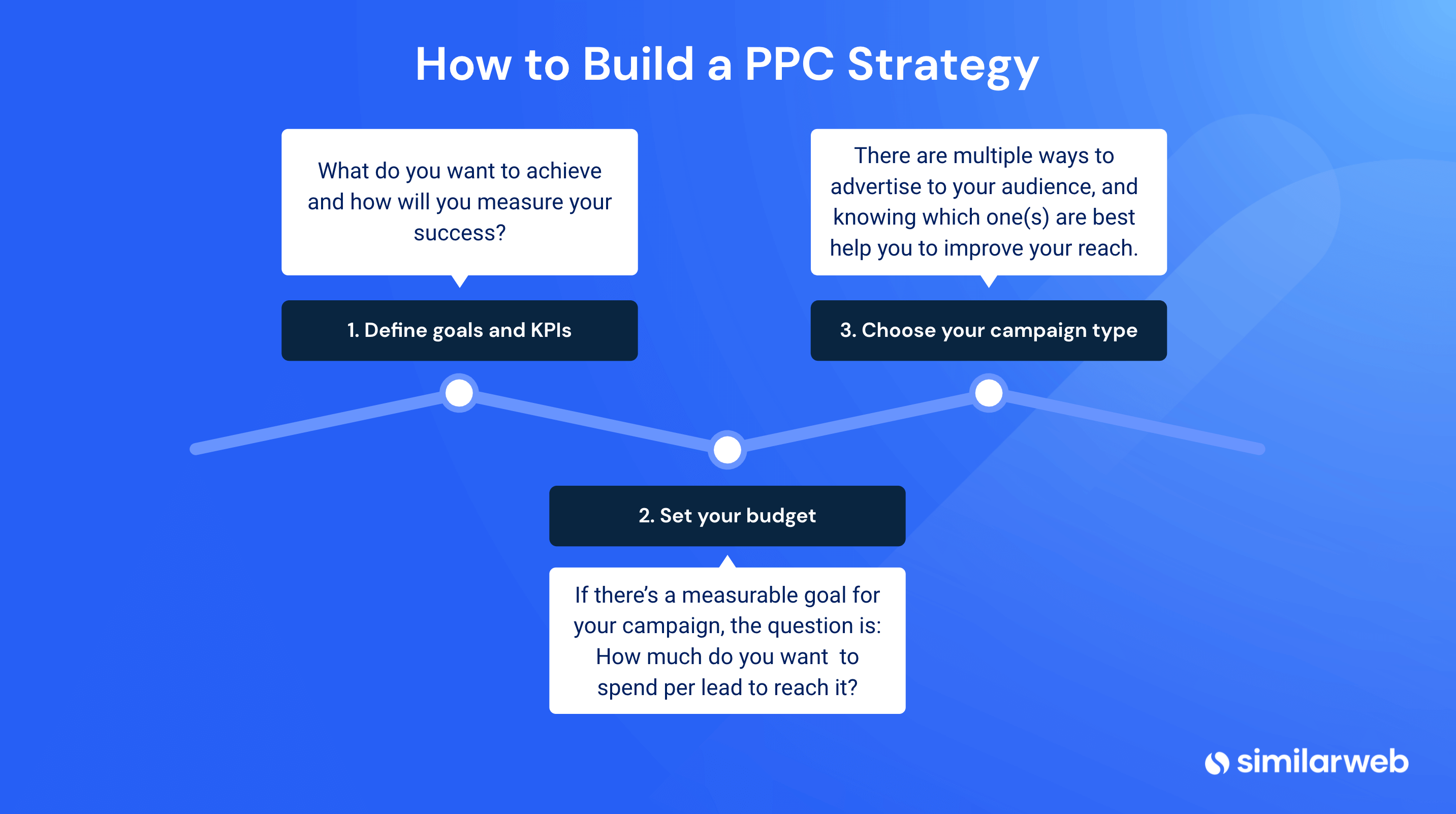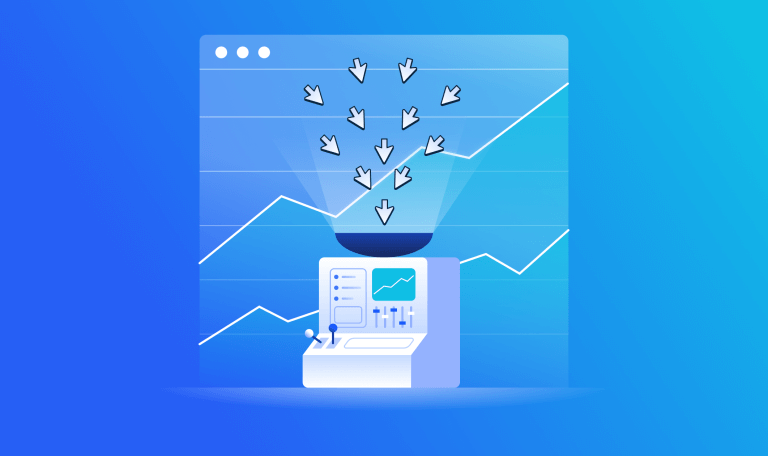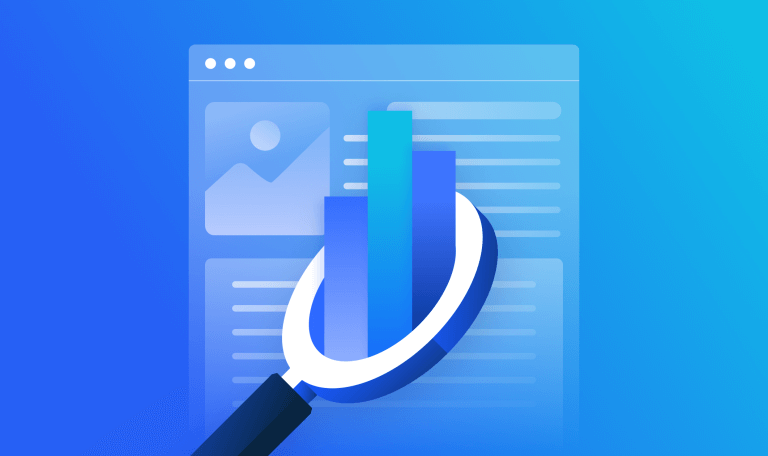 Marketing Intelligence
Marketing Intelligence
PPC Strategy Unleashed: Creating Campaigns That Work

Whether you’re a tried and true marketeer or new to the role, pay-per-click (PPC) advertising is the most effective way to quickly generate results and secure profits.
It helps you get your brand in front of interested parties (even if they don’t know it yet) and lets you test the waters. Most importantly, with the right ad analytics tools and know-how, honing an effective PPC strategy is pretty straightforward.
In this guide, we’ll walk you through how to develop a robust PPC campaign strategy, measure, and optimize your campaigns in a 10-minute read. If you’ve been doing PPC for ages and are just looking for a best practices refresher, drop down to the PPC best practices section.
What is PPC?
Pay-per-click (PPC) is an internet advertising model that lets you place ads online using platforms such as Google Ads and Bing. With PPC advertising, you’re only charged when users click on your ads, hence the name: “pay-per-click.”
How PPC works is simple: Every time there’s an ad spot on a search engine results page (SERP) for a keyword, an auction automatically takes place for that specific keyword.
Interested businesses then bid to appear for that keyword. Bids are set beforehand so the entire process is automated. The winner is selected based on several factors, including bid amount and ad quality, and shown in the top ad section.
More specifically, the top spot is based on the advertiser’s Ad Rank, a metric that’s calculated by multiplying the cost per click (CPC), the highest amount an advertiser is willing to spend, and Quality Score, a value that takes into account click-through rate, relevance, and landing page quality.
You can create accounts on platforms like Google Ads or Bing to set up and manage a PPC campaign, but just knowing what PPC is and how it works is only half the battle.
Knowing what you want to achieve is the other half. That’s right, you can use PPC campaigns to achieve different goals, from generating new leads and sales to promoting brand awareness and building authority on search engines. Ultimately, PPC is all about providing targeted content to your audience right when they need it.
What’s the true value of PPC?
With PPC advertising, you can drive targeted traffic to your website and reach people with a high degree of purchase intent for your offering.
For example, if you target the keyword term: “free accounting software,” you know that those who click on the link and arrive on the associated landing page are looking for accounting software.
Typically, those who click on ads are further into the buyer journey or sales funnel. They know what they’re looking for and are ready to find out more about a particular product, service or solution.
Of course, while you pay the advertising platform a fee every time your ad is clicked, when your PPC strategy works correctly, that fee is trivial because the visits are worth far more than what you pay for them. If a click costs you $5 in ad spend but you manage to close a $5,000 sale as a result of your PPC campaign, you’ve made a tremendous profit.
Creating and optimizing a PPC campaign requires:
- Targeting the right keywords and queries
- Organizing keywords into campaigns, lists, and ad groups
- Building and optimizing PPC landing pages to drive conversions
For many of the top companies, this starts with media buying and research tools for advertising creative. The right web analytics help you find the most effective ad formats and content, identify new opportunities, analyze competitors’ paid campaigns, and improve your own.
The benefits
PPC is one of the most powerful ways to generate leads quickly, all while controlling your spending.
Here are just a few of the main benefits of PPC:
- PPC ads are cost-effective
With PPC ad campaigns, you control how much you’re willing to spend per click (which is, in essence, your bid strategy). Since you only pay when visitors click on your link, you’ll get your money’s worth. One way of assessing the long-term performance of a PPC campaign is to look at its click-through rate (CTR) versus conversions. Using this approach, you can determine how many clicks will lead to a conversion and if they’re worth the spend.
- PPC ads produce fast results
It can take time to rank on search engines and attract organic traffic. PPC allows you to grab low-hanging fruit quickly and helps to increase your website authority. Think about it like this: If SEO is a marathon, PPC is a 500 meter dash. Using a mixture of paid advertising and organic marketing strategies actually should boost the impact of both strategies and grow your website’s reach.
- PPC ads allow you to target your ideal customers
With PPC, you can bid on keywords that your customers are searching. You can also hone your ideal audience based on demographics, past activity, and retargeting (engaging those who might have abandoned a cart).
- PPC can support your organic strategy
Your PPC and SEO strategy can work together to support each other. Use PPC to generate quick wins and support that activity with comprehensive SEO. Look for related terms you can target and build content around your paid campaigns.
The primary PPC platforms
Before we go into the key elements of building your PPC strategy, there are two main platforms for you to use:
Google Ads (previously Google AdWords)
Run on Google, Search Partner sites (other sites that expand the reach of a network), and Display Network sites, Google Ads is the largest PPC platform.
Microsoft Advertising
Similar to Google Ads, the Microsoft Advertising PPC platform shows ads on the Microsoft and Yahoo networks. There are also Search Partner networks for use.
While both platforms allow you to advertise (and you can import ads from one platform to another), they have three key differences: ad scheduling, search partner targeting, and in-market audience for search campaigns.
What’s the difference?
- Ad scheduling
For example, with ad scheduling on Google, the times at which your ads run is based on the timezone you choose when you create your account. Now, with Microsoft ads, ad schedules are based on the person viewing the ad.
What this means is that if you’re targeting multiple countries around the world using Google Ads and you want to display them during a certain time, you will have to set up separate campaigns. You can only change your account’s time zone once.
With Microsoft Advertising, however, your ad schedules are based on the location of the person viewing the ad. So you could still target multiple locations without several different campaigns.
- Search partner targeting
Both Google Ads (or Google AdWords) and Microsoft Ads have search partner networks – these are other sites that allow advertisers to expand the reach of their search network ads beyond the main google.com and bing.com domains.
For Google’s Search Partners, ads operate at the campaign level. This means that your ads will be shown on all search partner websites, should you choose to do so.
That said, some of the ad slots offered by Google Search Partners are poorly positioned (below the fold) and for users searching on websites other than Google, many of whom may have different intentions, your ads may not be relevant.
As for Microsoft Ads, these operate on an ad group level. In the tool, you have the option to show your ads on AOL and Yahoo networks, but there’s no option for target just bing.com. But if you see that one partner works better than the others, you can use the “target only” method for your ad groups (separated into owned, operated and syndicated) to maximize performance.
- In-market audiences
If you want to change your bids for specific audiences, such as those who are more likely to be actively researching or ready to buy a specific product or service, both Google Ads and Microsoft Ads allow advertisers to add in-market audiences to their network campaigns.
These targeted audiences can help generate results for your PPC campaigns, should you choose to use them. So take the time to see if you’re missing out on additional prospects every channel is different.
Winning more leads from your PPC strategy
Now that we’ve established what the two main platforms are and their differences, where do you start with your PPC strategy?
1. Define goals and KPIs
What do you want to achieve and how will you measure your success? We’re not talking about your campaign metrics but your overall objectives.
If you want to increase brand awareness, you might want to consider using Display Ads to support your copy. You can then measure brand awareness through social media engagement, direct traffic, surveys, and reviews.
What if you want to maximize lead generation? Well, you’ll want to create separate landing pages for each ad group and use PPC to target specific, intent-based queries that relate to what you have to offer.
So if you have marketing analytics software, something such as “marketing analytics software trial” or “free marketing analytics software” might be suitable as they will help drive targeted traffic to your landing pages.
You should also think about who you want to target. While there will be those interested in a marketing analytics software trial, not all of them will be prospects you want to work with. This is the time you can refer to your buyer persona research to ensure you get your ideal leads.
2. Set your budget
If there’s a measurable outcome to your campaign, the question is: How much do you want to spend per lead to reach that goal? That is your cost per acquisition (CPA).
So if a lead, on average, costs you $25 to convert and close, and that close nets you $20,000, you can see how powerful PPC can be.
That said, you may have to go through 300 leads before you get that one sale. The cost there being: $7,500. Less than the final sale, but still a considerable amount.
When setting a PPC budget, or ad spend, you’ll pay more for more “generic” and popular keyword terms. Thorough keyword research that focuses on longer-tail terms (three or four-word phrases) can save you money, since they often have lower search volume, they are often cheaper to bid on. Make sure to build a list of relevant keyword terms that are practical to go after.
Trainers, for instance, would be incredibly competitive and have a super-high CPC. But most advertisers, particularly in B2B, are happy to pay more per click because the product will recoup the investment and more. Also, the margins are typically good.
A good bid strategy combined with an idea of overall ad spend (how much you want to spend for your clicks), will help to maximize return on investment (ROI) when it comes to your PPC strategy.
3. Choose your campaign type
There are multiple ways to advertise your content to your audience, and knowing which one(s) are best will help you to improve your reach. You may even want to use a combination of them.
Search networks are the most common type of PPC ads. They refer to the text ads that show up on SERPs. Check out the example below:
Display network: Using the Google Display Network (GDN), you can place image-based ads on external networks.
Product listing ads (Shopping): These ads are most effective for eCommerce sites. Your ad, including an image, price, and short product description, will show on a carousel on a search page for your targeted keywords.
Remarketing/retargeting: Using remarketing/retargeting, you can connect with people who previously interacted with your website, whether that’s attempting (or forgetting) to make a purchase, downloading a guide, or reading one of your blogs.
Remarketing/retargeting works by putting ads in front of these people, encouraging them to continue engaging or pick up where they left off.
For example, you might start looking around for a new iPhone, select the iPhone 12 but forget to complete your purchase, or change your mind. Within minutes, you’ll start to see ads like the one below pop up on associated GDN websites.
Keyword research – choose your words carefully
The next step in your PPC advertising strategy is keyword research. Your campaigns are essentially divided into ad groups, and it’s these groups that define your campaign’s structure.
Each ad group you create needs to be assigned a set of keywords to target, this is how Google (and other search engines) know when and where to display your ad.
Relevant keywords are vital (and your landing page to boot), so we would advise selecting between one to five keywords per ad group. Your terms should be specific and, ideally, longer than one or two words (again, you’ll pay more for highly competitive terms).
If you have keywords that fall outside of ad groups, consider creating separate groups (if practical). You should also spend some time working out negative keywords, the ones you don’t want to be found for, and building keyword lists for the future.
Lastly, you’re not stuck with the keywords you start with. The best thing you can do is monitor the performance of your keywords and ad groups. You might see that your ads are getting lots of clicks but very few conversions. This could mean that the content offered on your landing page isn’t as relevant or valuable as it could be. Similarly, you could be getting steady conversions but very few clicks; this might mean that you’re targeting keywords that aren’t often searched.
Consider expanding your keyword research and optimizing your approach by using tools such as Similarweb. PPC is iterative and you want to constantly refine and expand your campaigns to reach your audiences.
Defining your campaign account structure
A core part of your PPC campaign strategy is defining your campaign’s account structure. To define your campaigns clearly, look through the terms you’ve identified from your keyword research (as mentioned previously) and think about the end action you want users to take when they arrive on your site using those terms.
Most accounts will have a few broad campaigns and then ad groups within those campaigns, e.g. a “Lead Generation” campaign could have ad groups for specific products/solutions.
Then within each ad group are keywords related to the product/solution that needs to be advertised. This helps you to segment your targeted terms and achieve a clear view of how your campaigns are performing and your overall account structure.
Tracking your campaigns
If you’re using Google Ads, Google Analytics is your best friend. It’s free to use so there’s no reason not to install it on your website. Using Google Analytics, you can get a detailed view of how your website is performing, how users interact with your pages, the content that’s attractive to your visitors, and how your keywords are performing.
But why not go a step further? With tools like Similarweb, you scale your PPC strategy significantly, leveraging media buying and ad creative research tools to uncover the most effective ad formats and content. You can also understand how your campaigns and your competitors’ are performing so that you can respond accordingly.
Last but not least, you can use our keyword research and analysis tools (that incorporate over 1 billion keywords) to build robust strategies based on reliable, real-world data. No more missing the mark.
And this is just the tip of the iceberg — from paid traffic analysis and display trends to paid media and ROI optimization, Similarweb can really supercharge your PPC campaign strategy.
PPC strategy best practices
Getting your ads in front of the right people and getting them to click is just half the battle, you also need to convince them to convert! Here are a few top tips to help that happen:
- PPC ad copy that speaks to your audience
Speak directly to your audience, highlight some of their challenges, include your main keyword (to reiterate the relevance of the ad), and include an actionable and clear CTA so that the searcher knows what to do next. Make your ad copy appealing by focusing on what the searcher wants and needs.
- Landing page optimization is the name of the game
Your content needs to match your chosen keywords and the intent of the searcher. You have to give them exactly what they’re looking for.
So if your target keyword is “PPC management software” and leads to a landing page, you should address the visitor’s challenges, and highlight how you can resolve their problems. You can include customer testimonials and an actionable CTA to lead them through the funnel seamlessly.
- A/B testing PPC ads
With A/B testing, you can increase the relevance of your ads, resulting in higher click-through rates and conversion rates.
The idea is to make minor (or major) tweaks to your ad copy, headlines, descriptions, landing pages, and target keywords to get the results you’re looking for. As mentioned previously, if you have a high click-through rate but a low conversion rate, chances are your landing page is missing the mark.
Consider A/B testing your landing page rather than your ads. Make another variation, sharpen the copy, identify some other relevant keyword terms and see how it compares to the original.
Conversely, if you have a low click-through rate but a high conversion rate, chances are your ad copy isn’t strong enough.
Think about the challenges your audience wants to solve and emphasize the unique value you offer them. When it comes to your overall marketing strategy, PPC is just one part. Sometimes thinking outside the box can help you come up with innovative ways to improve the results of your landing pages.
- Ad videos and visuals that leave an impression
It’s no surprise that strong images and videos perform the best online. In 2020, 78% of people watch videos online each week, and 55% say they watch them daily. Additionally, 99 percent of marketers claim they will continue to use video marketing in their approaches and 88 percent plan to increase ad spend on such campaigns in the future. Join this club asap.
Similarweb can help you with creative research to build your best video as well as search, product, and display ads. It enables you to identify and benchmark what ads and platforms work best for your competitors in order to improve (or start building) your campaigns and grow your market share.
Here we can see the video ads zales.com has been running for the last three months worldwide.
PPC made simple
There’s a lot to cover when it comes to PPC campaign strategy, which is exactly why many companies use PPC management tools to speed up the process. From automatically adjusting bids to providing insight on competitor performance, these solutions can empower you to do more with your advertising campaigns.
Similarweb Digital Marketing Intelligence provides you with data to do the research you need to create the most powerful PPC campaigns every step of the way from PPC competitor analysis and keyword research through ad research and media buying.
Our platform provides fresh insights based on real data, allowing you to optimize your PPC campaign strategy to meet the expectations of your audiences.
FAQs
What is PPC?
PPC is an online advertising model that allows you to place ads online. With PPC, you’re only charged when users click on your ads.
Why should I use PPC advertising?
You should use PPC advertising because it helps you to drive targeted traffic to your website, and reach audiences with high purchase intent for what you’re offering.
What are the benefits of PPC?
The benefits of PPC include creating cost-effective ads, producing fast results, and targeting your ideal audience.
The #1 PPC tool - get started
Give it a try or talk to our marketing team — don’t worry, it’s free!




















